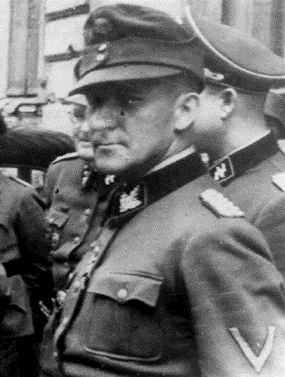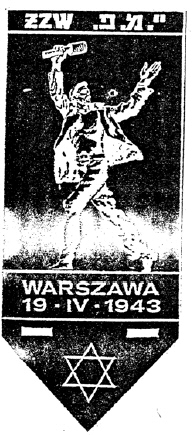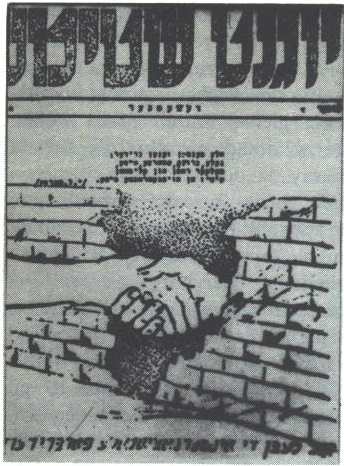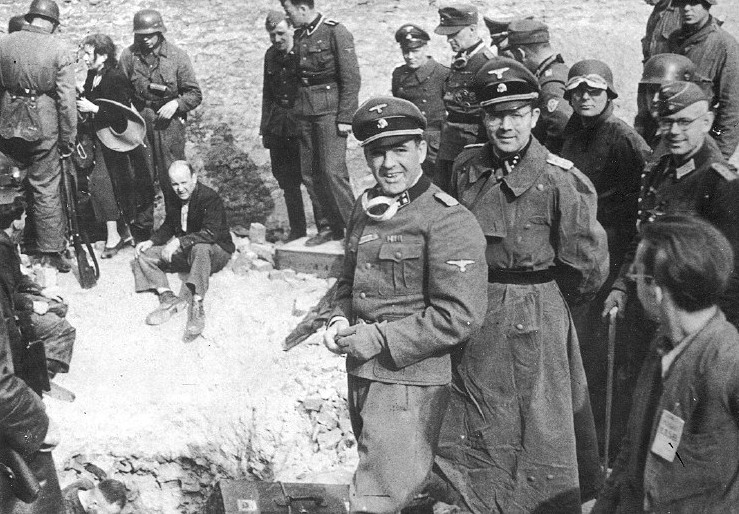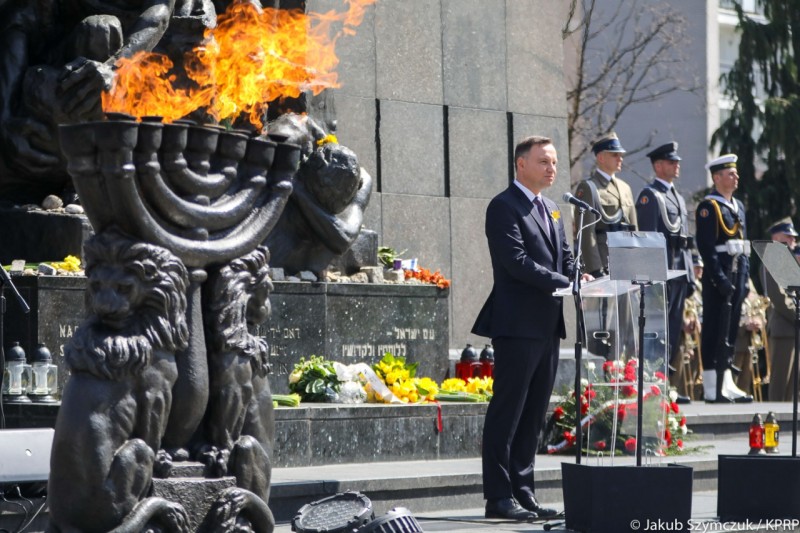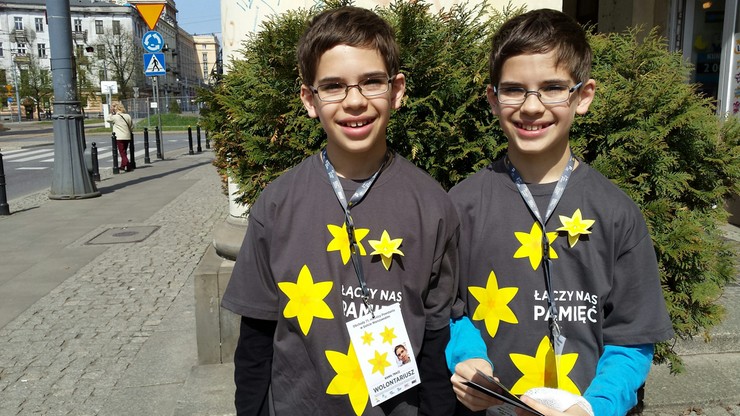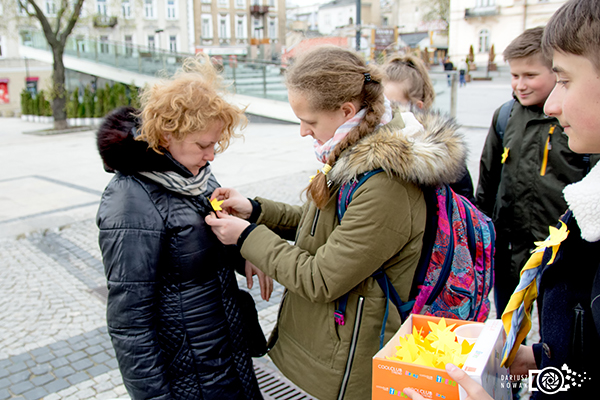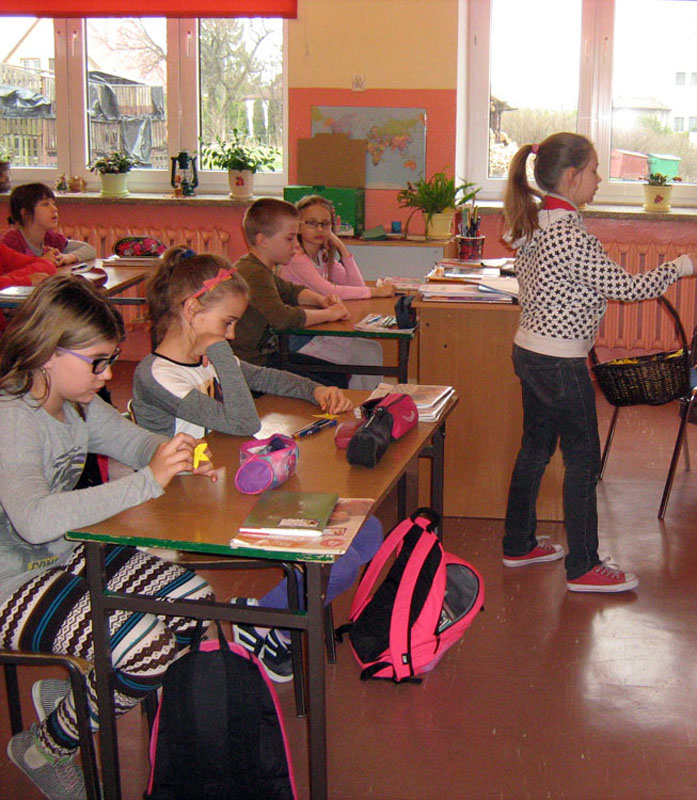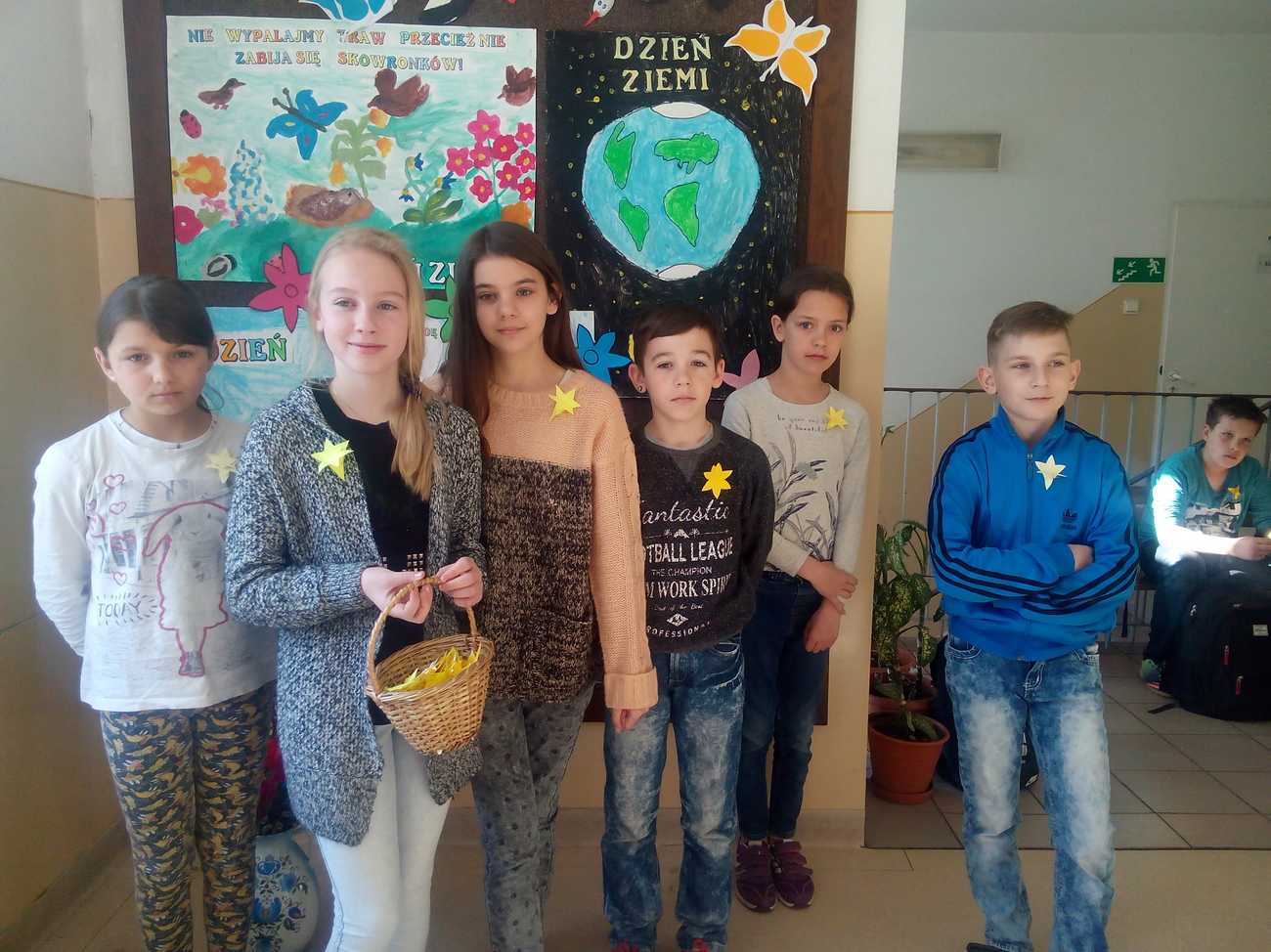Post by Bonobo on Jul 7, 2009 23:27:53 GMT 1
Many foreigners mistake two Warsaw Risings: Warsaw Ghetto 1943 and Warsaw 1944.
Warsaw 44 Rising was fought in the whole city by all inhabitants. Read about it here:
polandsite.proboards.com/index.cgi?board=polishhistory&action=display&thread=179
Warsaw Ghetto Rising 1943 was fought in the Jewish district.
The Warsaw Ghetto Uprising
by Y. Eric Bell
The New American
Monday, 29 June 2009
A premonition of death hovered over the medieval section of Warsaw. Surrounded by a 10-foot wall of brick and barbed wire, the most run-down section of Poland's capital was packed with some 500,000 Jews, nearly 10 times the number of people it originally housed. The time was October 1940, and the curtain had descended upon the Jews in Nazi-occupied Warsaw.
Inside the Ghetto ragged, barefooted, emaciated children wandered aimlessly about the streets. Orphans held the hands of their younger siblings, searching for shreds of life lost after the Nazis herded them into a nightmare. Their frostbitten hands, a by-product of the brutal Polish winter, groped feebly for morsels of food. Catatonic youngsters snuggled up to their mothers hoping for warmth from what had become just another corpse on the streets of Warsaw. Mothers, begging for food, traipsed the carcass-laden sidewalks clutching their dead babies which they refused to surrender for burial.
Hopeless skeletal adults looked away from these helpless children as they scrounged the streets to feed their hapless aging parents. Those who had collapsed from hunger were sprawled unconscious on the streets and sidewalks. By the winter of 1941, tens of thousands had perished from starvation and raging infectious diseases.
Shootings, hangings, beatings, and deception indiscriminately administered by German Fuhrer Adolf Hitler's storm troopers daily increased the toll. Fooled by SS promises of better living conditions, food, and work, many of the Jews in the Ghetto had volunteered to go "east." By the following summer, 80 percent of them had gone "east" to death camps. "The camp commandant at Treblinka told me that he had liquidated 80,000 in the course of half a year," SS Death Head Group officer and Auschwitz Commandant Rudolf Hoess frankly testified at the Nuremberg Trials. "He was principally concerned with liquidating all the Jews from the Warsaw ghetto." Terror led to madness and suicide as the doomed Ghetto dwellers heard about abattoirs at the end of some railway lines bearing names like Treblinka, Chelmno, and Auschwitz.
Some Jews decided to act, instead of going quietly into the night on the Treblinka express. Small groups of young Jews organized — among them the Zydowska Organizacja Bojowa (ZOB) and the Zydowski Zwiazek Wojskowy (ZZW). They recognized that their situation was dismal. They knew they were disarmed and surrounded, and that the mighty Nazi army they faced had subjugated much of Europe. Yet, without any realistic hope of success, they fought back. In so doing, they demonstrated once again that tyrants cannot stamp out man's yearning for freedom — a yearning that resides in the inner kingdom of the soul, beyond the reach of murderous dictatorships.
The Jewish Army Strikes
With an arsenal of only two pistols, the underground' s first and most important order of business was to procure guns. Jews operating covertly in "Aryan" Warsaw made use of relationships cultivated with the Polish underground, the Polish government in exile, and Jews in London, Palestine, and the United States in order to obtain weapons. Guns purchased through the black market and money from abroad to buy additional weapons were smuggled into the Ghetto. Women and children were taught to shoot.
As wild rumors of imminent mass roundups set off panic during the summer of '42, the Jewish army of the Warsaw Ghetto razed a warehouse filled with confiscated Jewish property. "We collected mattresses and furniture," Zivia Lubetkin proudly recalled. "Anything inflammable, [we] piled them together and set them on fire. Success! The flames swept into a great blaze and crackled in the night, dancing and twisting in the air. We rejoiced as we saw the reflection of the revenge that was burning inside us, the symbol of the Jewish armed resistance that we had yearned for, for so long."
Meanwhile, the SS increased the transports "east." Barbarous raids escalated day and night. Jews were shot at random for no apparent reason. Hysteria intensified as word came back to the Ghetto about deportations from other ghettos to the death camps at Belzec and Sobibor.
By the winter of 1942-43, nearly 300,000 Jews had been packed into cattle cars destined primarily for the gas chambers at Treblinka. In September 1942, an escapee from the death camp returned to the Ghetto with his horrid eyewitness testimony. It mirrored precisely what the other escapees revealed about the mass gassing and killing of Jews in Chelmno.
Jewish resisters distributed leaflets throughout the Ghetto to inform the 50,000 remaining Jews about Treblinka and specifically alert them about SS deceit. "Today every Jew should know the fate of those resettled," the leaflets warned. "The same fate awaits the remaining few left in Warsaw. The conclusion then is: Don't let yourself be caught! Hide, don't let yourself be taken away. Run away, don't be fooled by registrations, selections, numbers and roll calls! Jews, help one another! Take care of the children!"
The Jews went underground. They feverishly constructed bunkers and hideouts in anticipation of the final liquidation. The configuration was ingenious. Camouflaged entrances led to bunkers, secret rooms, attics, and basements that were inter-connected by newly constructed passageways. Through a maze of underground tunnels and sewers, the ZZW connected the Ghetto with "Aryan" Warsaw. Electricity was adroitly diverted from the Warsaw power grids. The resisters set up illegal radios to communicate with the various underground units. Food and supplies acquired from warehouses were cleverly stored. An extraordinary subterranean defense was erected in days.
Guns, however, remained the most important life and death priority. The Jewish underground did not get much help from the Polish Home Army. "As a trial I gave them a few pistols," Commander in Chief Stefan Rowecki radioed his superiors in London in January 1943, "I am not sure they will use the weapons altogether. More weapons I will not give." Weapons purchased at extravagant costs were smuggled in by couriers, oftentimes by children. And after exhaustive meetings with the Polish Home Army, the underground negotiated for some 60 revolvers, dozens of hand grenades and various explosives.
The Ghetto Jews Go to War
On January 18, 1943, the SS, as well as Latvian, Lithuanian, Ukrainian and Polish forces, looking to sweep up thousands for transport to the "east," came face to face with the Ghetto Jewish resistance. "No one believed we would survive. Me neither," recalled Shalom Stefan Grayek. "But I just wanted one thing. I wanted to avenge myself and those who murdered my family, my friends and my people."
Many SS fell in battle as Jews struck first with grenades, Molotov cocktails, and incendiary devices, and then picked them off with ease when the SS forces were caught in a crossfire while making their retreat. Lacking weaponry, the Jewish resistance used every means at their disposal to expel the enemy, even deploying boiling water from above.
Amidst the explosions, whizzing bullets, and blinding smoke, underground members dashed onto the streets to retrieve weapons, grenades, and ammunition from the dead and wounded. Every grenade, gun and bullet had great value! The valiant resistance from rooftops, bunkers, attics and makeshift defensive positions forced the SS and their friendly "volunteers" to evacuate.
The mighty German army was stunned and confused. "SS agents who stood some distance away and many gendarmes who fled in confusion cried out: `The Jews are shooting!'" remembered Yitzhak Katznelson. "I, myself, heard these astonished cries from the lips of a vile loathsome German as he ran down the stairs of the house which he had entered for the deliberate purpose of killing us. `The Jews are shooting!' he cried out in utter bewilderment. Something unheard of! Jews firing! `They have guns!'" Estimates placed Third Reich casualties at nearly 200. More than 600 Jews died, and an additional 5,000 were grabbed and sent on to their deaths.
The Jewish victory electrified the insurgents and those in hiding. Morale energized the Ghetto Jews as they celebrated their Homeric victory over Hitler's forces. In Berlin, however, the mood was quite different. The German retreat terrified the Nazi high command, including Minister of Propaganda Joseph Goebbels. "The Jews have actually succeeded in making a defensive position of the Ghetto," complained Goebbels. "Heavy engagements are being fought there which led even to the Jewish Supreme Command issuing daily communiques. Of course this fun won't last long." Little did Goebbels realize that the operation, which the experienced SS expected to complete in several days, would instead drag on for months. "It shows what is to be expected of the Jews when they are in possession of arms," he warned.
Fighting to the End
While Jews worldwide commemorated the Exodus of Hebrews from Pharaoh's enslavement in Egypt, Hitler's SS was poised to carry out their Fuhrer's order at daybreak — the hellish deportation of all Jews from the Warsaw Ghetto to death camps in the "east." In the parlance of the Supreme Leader's new world order, this was known as "resettlement. "
On hand this time was the experienced 48-year-old SS General Juergen Stroop. Seasoned in crushing partisan resistance and massacring civilians, the general was ready to assume direct command if anything like the January fiasco occurred.
The underground, meanwhile, readied itself for the assault. Its leader, Mordechai Anielewicz, who was half Stroop's age, gave the command. "He who has arms will fight. He who has no arms — women and children — will go down into the bunkers."
Jews rushed about the Ghetto in a frenzy, finding places to hide. Some descended into sewers. Others scrambled into prepared hiding places in cellars and attics. They squeezed into vaults, behind and inside furniture, and below floor openings. Unimaginably, some even sought refuge in latrines.
At 6:00 a.m. on April 9, 1943, more than 2,000 SS soldiers, along with additional Latvian, Lithuanian, and Ukrainian volunteers, advanced onto the silent, eerie and deserted streets of the Warsaw Ghetto. This time they brought tanks. Armed with heavy and hand-held machine guns, howitzers, and rifles, the nervous invading army hugged the sides of buildings as it carefully made its way through the ghost town. Artillery support was ready. An underground lookout with his pistol and hand grenades spotted the skull and crossbones and alerted his commander.
Overwhelmingly outnumbered, overmatched and outgunned, the resistance struck first with grenades, Molotov cocktails, and incendiary bottles. Then it attacked with machine gun, rifle and pistol fire. A tank burst into flames. Mangled, burned, and bullet-riddled German assault forces lay dead on the bloody streets. After fierce fighting, Colonel von Sammern-Frankenegg' s troops hastily retreated.
"When the Germans came up to our posts and marched by and we threw those hand grenades and bombs, and saw German blood pouring over the streets of Warsaw, after we saw so much Jewish blood running in the streets of Warsaw before that, there was rejoicing," boasted a proud Zivia Lubetkin. "And after an hour we saw the officer hastening his soldiers to retreat, to collect their dead and their wounded. But they did not move, they did not collect their dead and their wounded. We took their arms later. And thus on the first day, we the few with our poor arms drove the Germans away from the ghetto." The Germans left behind some 20 casualties.
SS General Stroop was stunned and embarrassed. He was especially incensed by a blue and white Hebrew flag hoisted from a window. With the blessings of his boss, Heinrich Himmler, Stroop took command. He initially ordered his troops, with assistance from petrified Jewish prisoners, to lure Jews out of hiding with promises of food, jobs, and housing if they peacefully resettled east. The Ghetto Jews did not bite. Recognizing the deception, and ignoring the subsequent order to surrender, the resistance fought back with hand grenades and explosives. Stroop called for artillery. The resistance withstood the barrage and heavy gunfire exchanges. After hours of brutal fighting, Stroop saw his troops pull back again.
As the latest Nazi offensive collapsed, Stroop realized he had underestimated Jewish resolve and courage. As he acknowledged in his final report to Berlin, "It became apparent that the Jews no longer had any intention to resettle voluntarily, but were determined to resist evacuation.. .. Over and over again new battle groups consisting of 20 to 30 Jewish men, accompanied by a corresponding number of women, kindled new resistance."
In the ensuing days, the Nazis set buildings ablaze in order to drive the fighters out. Electricity, gas, and water were cut off. The SS attacked the Jewish hospital and killed the wounded and infirm in their beds. Those who tried to escape the carnage by hiding were burned alive when the SS torched the building. Yet again, Stroop's men were repulsed, unable to carry out his orders to remove and destroy the Hebrew flag. The presence of the flag nauseated Stroop, as it was a symbolic reminder that a rag-tag Jewish military unit was holding its own against the vaunted Master Race.
As Jews celebrated the SS retreat, pride swelled and reached all the way to Vilna where poet Shmerl Kaczerginski, who learned about the events from illegal radio, responded: "We know of no other particulars yet.... We suddenly saw clearly the flames of the Warsaw ghetto and Jews fighting with arms for their dignity and self-respect. "
The news also reached Berlin. A furious Heinrich Himmler commanded Stroop to crush the resistance "with ruthless and murderous tenacity." SS General Stroop ordered his forces to burn down the entire Ghetto.
Bewildered, scared, and embarrassed Nazi units once again assaulted the Ghetto, flamethrowers in hand to burn down every building and bunker in sight. "Our brave defenders are holding out at their posts," Leon Najberg reported. "Germans — in spite of everything — have to fight for access to each house. Gates of houses are barricaded, each house in the Ghetto is a defensive fortress, each flat is a citadel — Jewish defenders are showering missiles from flats' windows and throwing shells at bandits."
The Ghetto was ablaze. Jews were burned alive in their bunkers and hiding places. Some were blasted and tear-gassed out of their defensive positions. "Jews usually left their hideouts, but frequently remained in the burning buildings and jumped out of the windows only when the heat became unbearable. They then tried to crawl with broken bones across the street into buildings which were not afire," Stroop recorded in his report. Many of the victims became running torches.
During these days of vicious combat, the Jews' bunkers and resistance positions were systematically destroyed. Running out of grenades and incendiary bombs, the resistance adopted a different strategy — guerrilla warfare. Armed mostly with pistols, they used hit and retreat tactics to repel the onslaught. Many in the invading army were killed and their weapons were retrieved. Jews suffered heavy losses as well. A number of captured Jews were shot on the spot. Others were sent to crowded, filthy holding pens to join deportees awaiting "resettlement. "
The sky over Warsaw was red for many days from the flames of the burning Ghetto, the smoke so thick that fighters fleeing the inferno could not see ahead. Yet the carnage was quite visible to all on the other side of the wall. "On the balcony of the second floor a woman stood wringing her hands," observed Feigele Peltel, who was hiding in "Aryan" Warsaw. "She disappeared into the building but returned a moment later, carrying a child and dragging a featherbed, which she flung to the pavement to break her fall. Clutching her child, she started to climb over the railing. A spray of bullets caught her midway — the child dropped to the street — the woman's body dangled lifeless from the railing."
With the German forces and Jewish fighters engaged in savage street-to-street and house-to-house fighting, Stroop's strategy of divide and conquer seemed to be working. The underground units became more isolated and splintered after the SS released gas into the bunkers. As Jews emerged for air, many were immediately shot. Those who escaped through the mazes of underground tunnels, passageways, and sewers tried to get word to their comrades. Many of the freedom fighters, cut off in the mayhem, were buried under the collapsing walls and masonry of their bunkers. For the wounded, there was no medication. A doctor did his best without anesthesia. Supplies dwindled and were difficult to obtain.
Meanwhile, Commander Anielewicz desperately awaited a response from a note sent to associates operating in "Aryan" Warsaw: "A revolver has no value for us; its use is limited. We have urgent need of hand grenades, submachine guns and explosives." He did not get what he needed. Yet in spite of the growing awareness that the end of their rebellion was imminent, Anielewicz was proud to have served with the Ghetto Jews. "The dream of my life has become a reality," he said. "I lived to see Jewish defense in the ghetto in all its greatness and splendor."
When the SS discovered that Jews were escaping to the "Aryan" side through the sewer system, they released more gas into the sewers. They also deployed dogs and sound-detection devices in order to locate any Jews still hiding in the rubble. In spite of the great danger to his troops, Stroop even sent his men into the Ghetto at night to surprise the holdouts.
Eventually, the Nazi forces succeeded in battling their way to the resistance bunker headquarters on Mila Street. The remaining 120 underground fighters realized that all was lost. They could no longer halt the Nazi onslaught. Many committed suicide. Others took their commander's advice to escape into "Aryan" Warsaw. Some, with help from the Polish underground, were able to reach the forests. Many died from the gas which the Germans discharged into the command post. Among the dead was the valiant Commander Anielewicz. Those who surrendered were either shot or transported to the death camps. By May 8, 1943, the Ghetto had been destroyed and the uprising was over.
According to SS General Stroop, more than 56,000 Jews were liquidated during the uprising. Jews mutilated in explosions, incinerated by fires, and buried under the rubble remain forever unaccounted for. Ultimately, Stroop's SS burned down the Warsaw synagogue, reducing to ashes some 900 years of Jewish heritage in Poland. The military victory over the Warsaw Ghetto resisters was boastfully described in detail in Stroop's leather-bound report sent to Berlin, entitled Es gibt keinen judischen wohnbezirk in Warschau mehr! ("There is no longer a Jewish district in Warsaw!")
A Personal Reflection
Perhaps the meaning of the Warsaw Ghetto and the Jewish uprising is best conveyed by those who survived Hitler's "Final Solution." Lola, who escaped from the Stolpce Ghetto in Byelorussia (White Russia) on the eve of its liquidation, and who took up arms as a partisan during the remainder of the war, reminds us: "Be on alert for government. Big government. There will always be incidents in which people will be killed by gangs or thugs. Twenty, thirty, a hundred maybe. A tragedy for sure. But only a big government can organize to murder millions. And very important! Listen to what people say. They will let you know in advance what they have in mind."
Lola's husband Yehuda, who was a partisan commander in the Byelorussian forest of Naliboki during WWII, and who later served as an officer in the Israeli Defense Force, recalls a 1941 rescue effort: "We went into a ghetto to rescue some family and friends.... Some very religious Jews, who were praying, refused to come. They said that God will take care of them. I showed them my gun and told them, `With all respect to God, this is the only thing that will save you here.'" The partisans and the escapees survived the war. Those who stayed behind were shot. Yehuda and Lola became American citizens in 1957. They are my parents and taught me well.
www.isurvived.org/home.html
Jews captured during the Warsaw Ghetto Uprising are led by German soldiers to the assembly point for deportation.
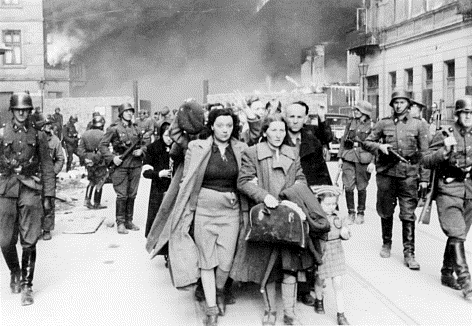

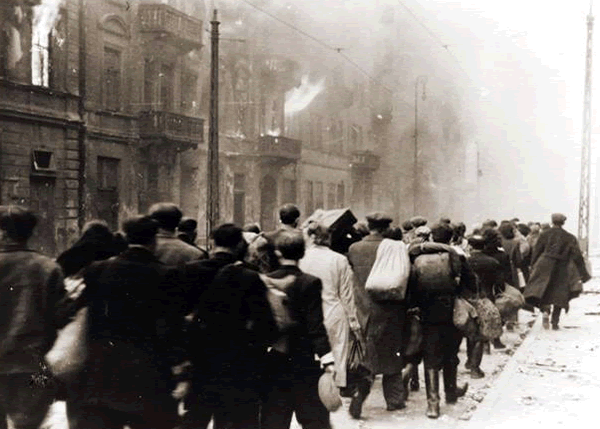
An SS sergeant interrogating Jews captured during the suppression of the Warsaw Ghetto Uprising.
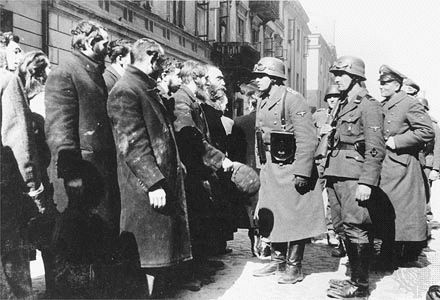
One of the most famous pictures of the Holocaust. German storm troopers force Warsaw ghetto dwellers of all ages to move, hands up, during the Warsaw Ghetto Uprising
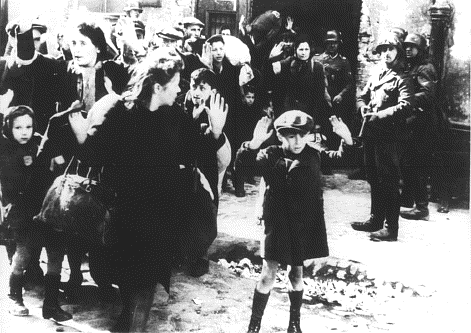
To the Little Polish Boy Standing With His Arms Up
by
Peter L. Fischl
.
Little Polish Boy
I.
I would like to be an artist
So I could make a Painting of you
Little Polish Boy
Standing with your Little hat on your head
The Star of David on your coat
Standing in the ghetto with your arms up as many Nazi machine guns pointing at you
I would make a monument of you and the world who said nothing
I would like to be a composer so I could write a concerto of you
Little Polish Boy
Standing with your Little hat on your head
The Star of David on your coat Standing in the ghetto with your arms up as many Nazi machine guns pointing at you
I would write a concerto of you and the world who said nothing
.
II.
I am not an artist
But my mind had painted
a painting of you
Ten Million Miles High is the Painting
so the whole universe can see you Now
Little Polish Boy
Standing with your Little hat
on your head
The Star of David
on your coat
Standing in the ghetto with your arms up as many Nazi machine guns pointing at you
And the World who said nothing
I'll make this painting so bright
that it will blind the eyes
of the world who saw nothing
Ten billion miles high will be the monument
so the whole universe can remember of you
Little Polish Boy
Standing with your Little hat
on your head
The Star of David
on your coat
.
III.
Standing in the ghetto
with your arms up
as many Nazi machine guns pointing at you
And the monument will tremble so the blind world
Now will know
What fear is in the darkness
The world
Who said nothing
I am not a composer
but I will write a composition
for five trillion trumpets
so it will blast the ear drums
of this world
The world's
Who heard nothing
I
am
Sorry
that
It was you
and
Not me
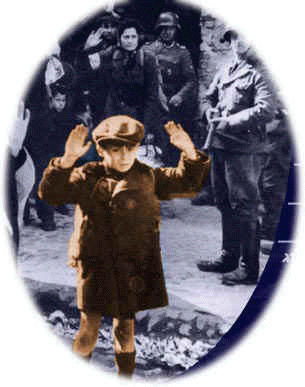
Underground Resistance fighters in the Warsaw Ghetto Uprising, 1943




SS officers interrogate a captured resistance fighter during the Warsaw Ghetto Uprising
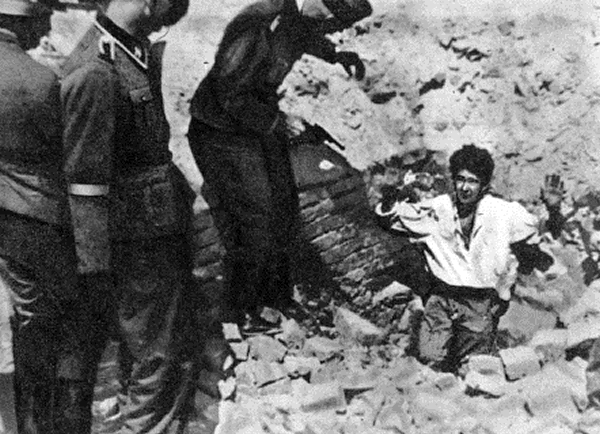
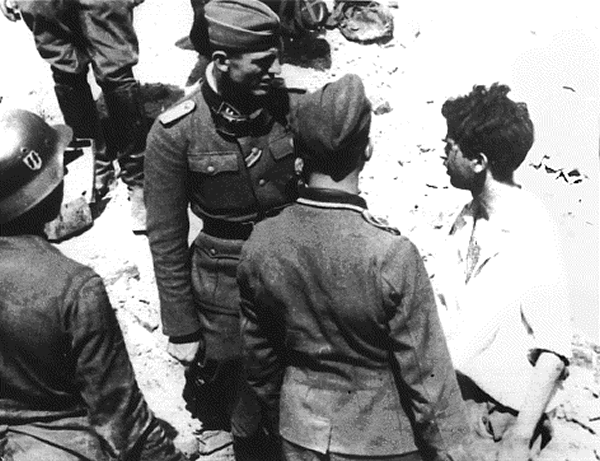
German commander of SS troops - Jurgen Stroop.

He was aided by renegade Latvian, Lithuanian and Ukrainian troops. Here, Ukrainian cleaning-up units.

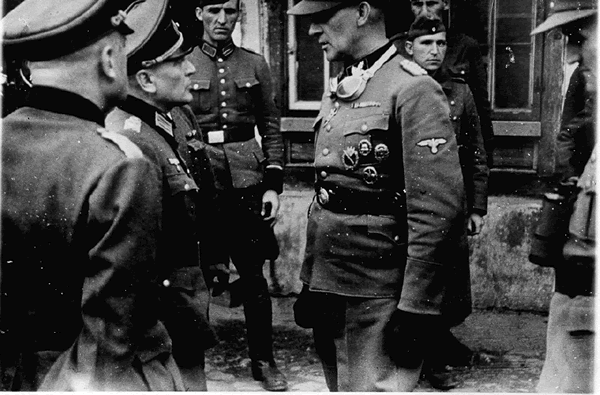
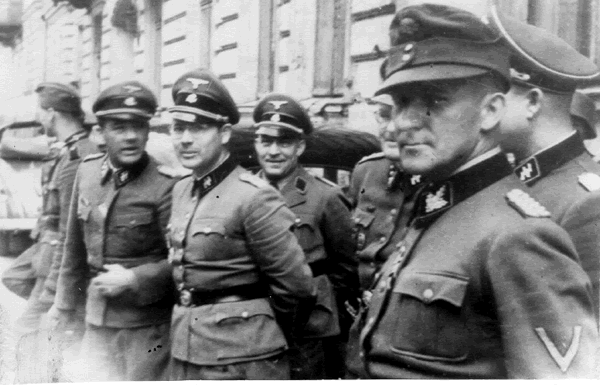
Mordechai Anielewicz (1919-1943), commandant of the ZOB during the Warsaw Ghetto Uprising. He fell on May 8, 1943.
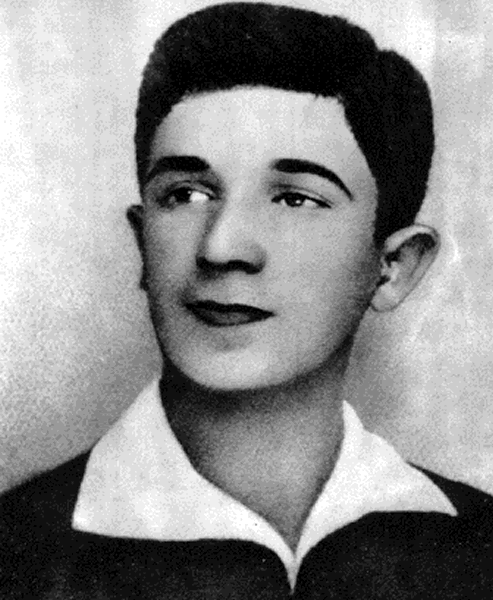
A German gun crew prepares to shell the ruins of a building during the suppression of the Warsaw Ghetto Uprising.
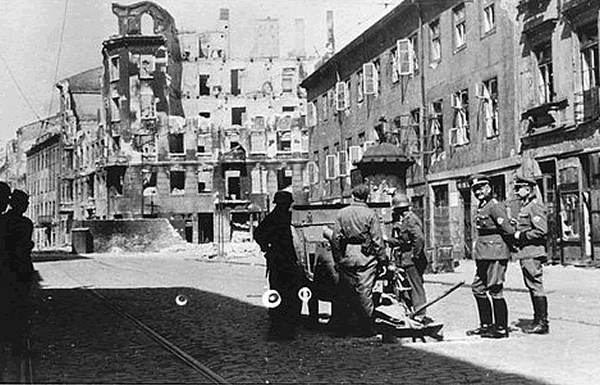
www.eilatgordinlevitan.com/warsaw/w_pages/warsaw_ghetto_scenes.html
Jews are found in a bunker during the Warsaw Ghetto Uprising in May 1943
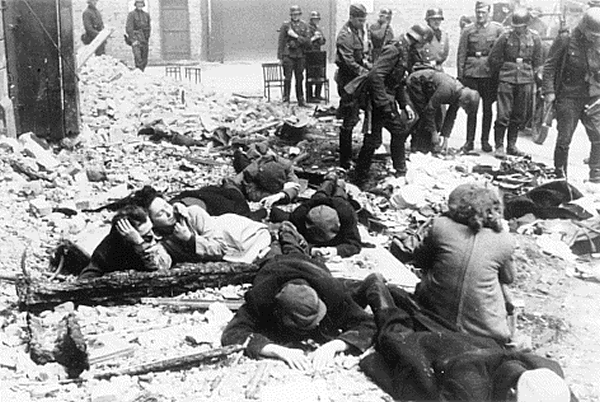
A woman hangs from a balcony, preparing to drop to the street and the waiting SS.
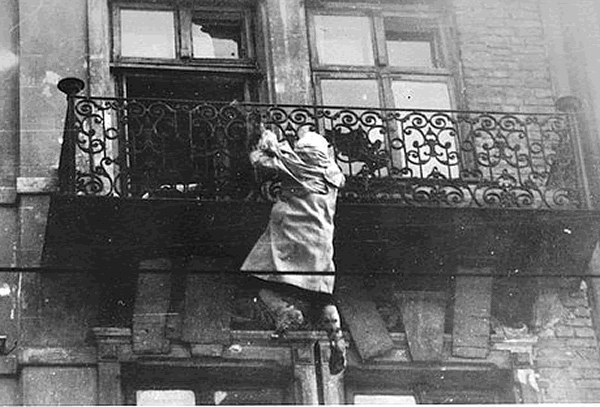
"The SS thugs set ablaze entire blocks of flats in order to force the population to come out of hiding...the water, gas, and electric supplies were cut off...."
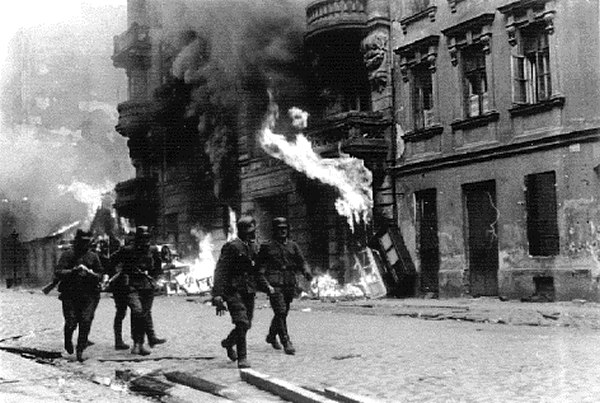

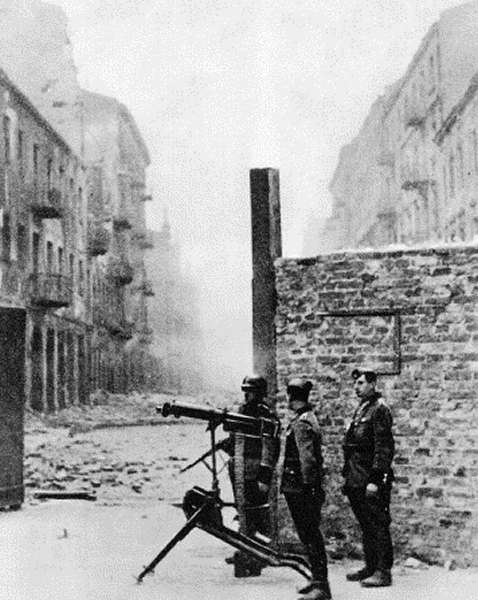
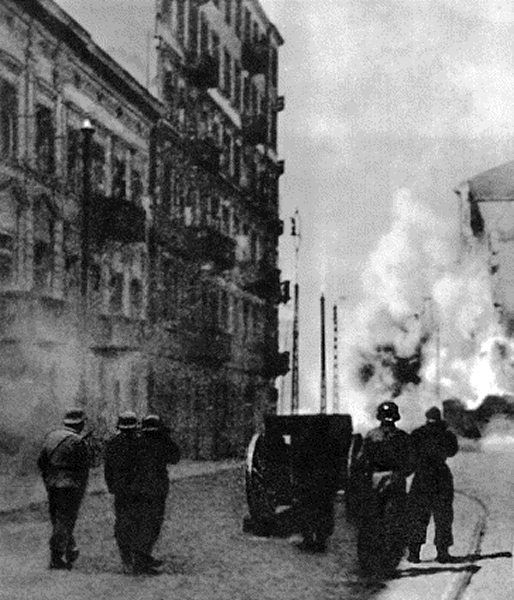
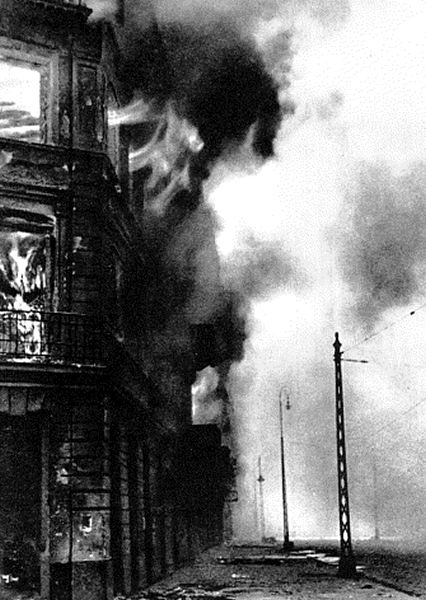
SS troops and officers search the Jewish department heads of the Brauer armaments factory during the suppression of the Warsaw Ghetto Uprising.
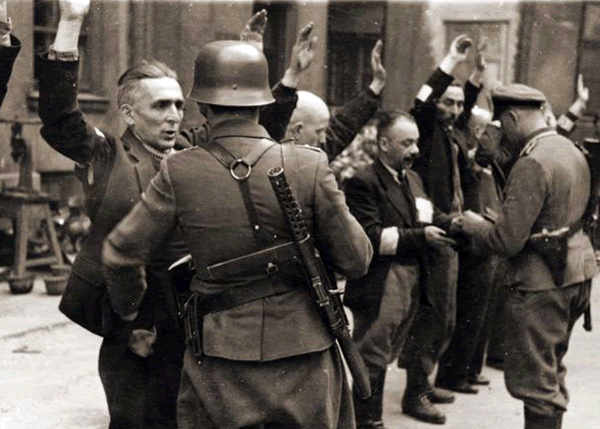
Jews captured by the SS during the Warsaw Ghetto Uprising are interrogated beside the ghetto wall before being sent to the Umschlagplatz. The original German caption reads: "Search and Interrogation."
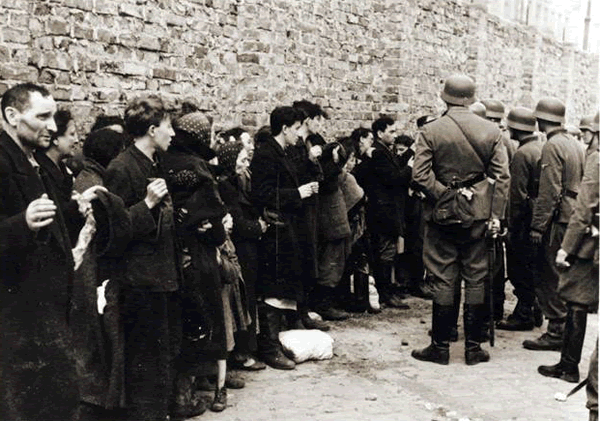
The bodies of Jewish resisters lie in front of the ruins of a building where they were were shot by the SS during the suppression of the Warsaw Ghetto Uprising. The original German caption reads: "Bandits killed in battle."
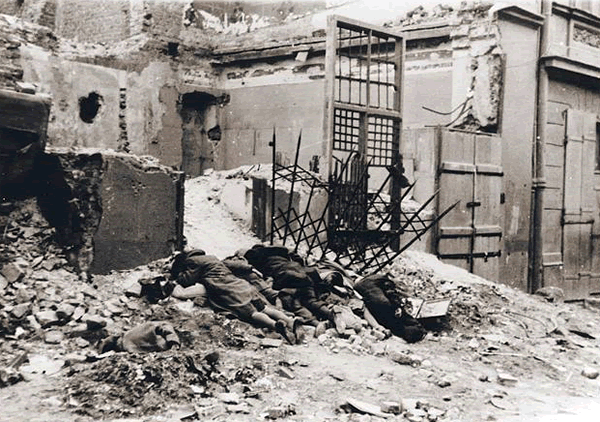
What Germans did to the Ghetto area after the Rising fell.
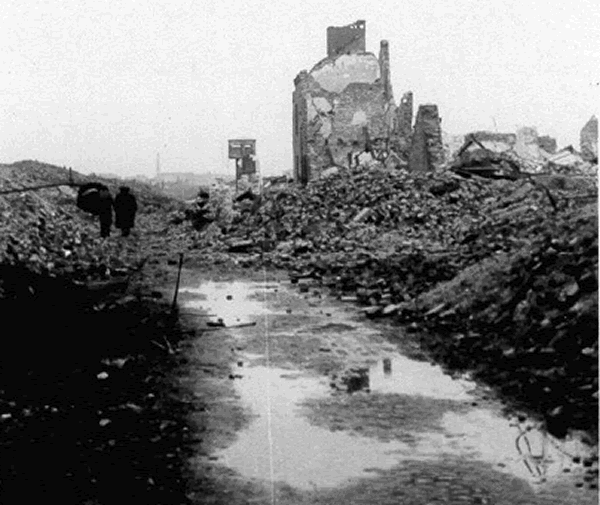
Pictures and descriptions mostly from these two sites:
www.eilatgordinlevitan.com/warsaw/w_pages/warsaw_ghetto_scenes.html
www.isurvived.org/home.html
www.ushmm.org/wlc/media_ph.php?lang=en&ModuleId=10005188&MediaId=705
Warsaw 44 Rising was fought in the whole city by all inhabitants. Read about it here:
polandsite.proboards.com/index.cgi?board=polishhistory&action=display&thread=179
Warsaw Ghetto Rising 1943 was fought in the Jewish district.
The Warsaw Ghetto Uprising
by Y. Eric Bell
The New American
Monday, 29 June 2009
A premonition of death hovered over the medieval section of Warsaw. Surrounded by a 10-foot wall of brick and barbed wire, the most run-down section of Poland's capital was packed with some 500,000 Jews, nearly 10 times the number of people it originally housed. The time was October 1940, and the curtain had descended upon the Jews in Nazi-occupied Warsaw.
Inside the Ghetto ragged, barefooted, emaciated children wandered aimlessly about the streets. Orphans held the hands of their younger siblings, searching for shreds of life lost after the Nazis herded them into a nightmare. Their frostbitten hands, a by-product of the brutal Polish winter, groped feebly for morsels of food. Catatonic youngsters snuggled up to their mothers hoping for warmth from what had become just another corpse on the streets of Warsaw. Mothers, begging for food, traipsed the carcass-laden sidewalks clutching their dead babies which they refused to surrender for burial.
Hopeless skeletal adults looked away from these helpless children as they scrounged the streets to feed their hapless aging parents. Those who had collapsed from hunger were sprawled unconscious on the streets and sidewalks. By the winter of 1941, tens of thousands had perished from starvation and raging infectious diseases.
Shootings, hangings, beatings, and deception indiscriminately administered by German Fuhrer Adolf Hitler's storm troopers daily increased the toll. Fooled by SS promises of better living conditions, food, and work, many of the Jews in the Ghetto had volunteered to go "east." By the following summer, 80 percent of them had gone "east" to death camps. "The camp commandant at Treblinka told me that he had liquidated 80,000 in the course of half a year," SS Death Head Group officer and Auschwitz Commandant Rudolf Hoess frankly testified at the Nuremberg Trials. "He was principally concerned with liquidating all the Jews from the Warsaw ghetto." Terror led to madness and suicide as the doomed Ghetto dwellers heard about abattoirs at the end of some railway lines bearing names like Treblinka, Chelmno, and Auschwitz.
Some Jews decided to act, instead of going quietly into the night on the Treblinka express. Small groups of young Jews organized — among them the Zydowska Organizacja Bojowa (ZOB) and the Zydowski Zwiazek Wojskowy (ZZW). They recognized that their situation was dismal. They knew they were disarmed and surrounded, and that the mighty Nazi army they faced had subjugated much of Europe. Yet, without any realistic hope of success, they fought back. In so doing, they demonstrated once again that tyrants cannot stamp out man's yearning for freedom — a yearning that resides in the inner kingdom of the soul, beyond the reach of murderous dictatorships.
The Jewish Army Strikes
With an arsenal of only two pistols, the underground' s first and most important order of business was to procure guns. Jews operating covertly in "Aryan" Warsaw made use of relationships cultivated with the Polish underground, the Polish government in exile, and Jews in London, Palestine, and the United States in order to obtain weapons. Guns purchased through the black market and money from abroad to buy additional weapons were smuggled into the Ghetto. Women and children were taught to shoot.
As wild rumors of imminent mass roundups set off panic during the summer of '42, the Jewish army of the Warsaw Ghetto razed a warehouse filled with confiscated Jewish property. "We collected mattresses and furniture," Zivia Lubetkin proudly recalled. "Anything inflammable, [we] piled them together and set them on fire. Success! The flames swept into a great blaze and crackled in the night, dancing and twisting in the air. We rejoiced as we saw the reflection of the revenge that was burning inside us, the symbol of the Jewish armed resistance that we had yearned for, for so long."
Meanwhile, the SS increased the transports "east." Barbarous raids escalated day and night. Jews were shot at random for no apparent reason. Hysteria intensified as word came back to the Ghetto about deportations from other ghettos to the death camps at Belzec and Sobibor.
By the winter of 1942-43, nearly 300,000 Jews had been packed into cattle cars destined primarily for the gas chambers at Treblinka. In September 1942, an escapee from the death camp returned to the Ghetto with his horrid eyewitness testimony. It mirrored precisely what the other escapees revealed about the mass gassing and killing of Jews in Chelmno.
Jewish resisters distributed leaflets throughout the Ghetto to inform the 50,000 remaining Jews about Treblinka and specifically alert them about SS deceit. "Today every Jew should know the fate of those resettled," the leaflets warned. "The same fate awaits the remaining few left in Warsaw. The conclusion then is: Don't let yourself be caught! Hide, don't let yourself be taken away. Run away, don't be fooled by registrations, selections, numbers and roll calls! Jews, help one another! Take care of the children!"
The Jews went underground. They feverishly constructed bunkers and hideouts in anticipation of the final liquidation. The configuration was ingenious. Camouflaged entrances led to bunkers, secret rooms, attics, and basements that were inter-connected by newly constructed passageways. Through a maze of underground tunnels and sewers, the ZZW connected the Ghetto with "Aryan" Warsaw. Electricity was adroitly diverted from the Warsaw power grids. The resisters set up illegal radios to communicate with the various underground units. Food and supplies acquired from warehouses were cleverly stored. An extraordinary subterranean defense was erected in days.
Guns, however, remained the most important life and death priority. The Jewish underground did not get much help from the Polish Home Army. "As a trial I gave them a few pistols," Commander in Chief Stefan Rowecki radioed his superiors in London in January 1943, "I am not sure they will use the weapons altogether. More weapons I will not give." Weapons purchased at extravagant costs were smuggled in by couriers, oftentimes by children. And after exhaustive meetings with the Polish Home Army, the underground negotiated for some 60 revolvers, dozens of hand grenades and various explosives.
The Ghetto Jews Go to War
On January 18, 1943, the SS, as well as Latvian, Lithuanian, Ukrainian and Polish forces, looking to sweep up thousands for transport to the "east," came face to face with the Ghetto Jewish resistance. "No one believed we would survive. Me neither," recalled Shalom Stefan Grayek. "But I just wanted one thing. I wanted to avenge myself and those who murdered my family, my friends and my people."
Many SS fell in battle as Jews struck first with grenades, Molotov cocktails, and incendiary devices, and then picked them off with ease when the SS forces were caught in a crossfire while making their retreat. Lacking weaponry, the Jewish resistance used every means at their disposal to expel the enemy, even deploying boiling water from above.
Amidst the explosions, whizzing bullets, and blinding smoke, underground members dashed onto the streets to retrieve weapons, grenades, and ammunition from the dead and wounded. Every grenade, gun and bullet had great value! The valiant resistance from rooftops, bunkers, attics and makeshift defensive positions forced the SS and their friendly "volunteers" to evacuate.
The mighty German army was stunned and confused. "SS agents who stood some distance away and many gendarmes who fled in confusion cried out: `The Jews are shooting!'" remembered Yitzhak Katznelson. "I, myself, heard these astonished cries from the lips of a vile loathsome German as he ran down the stairs of the house which he had entered for the deliberate purpose of killing us. `The Jews are shooting!' he cried out in utter bewilderment. Something unheard of! Jews firing! `They have guns!'" Estimates placed Third Reich casualties at nearly 200. More than 600 Jews died, and an additional 5,000 were grabbed and sent on to their deaths.
The Jewish victory electrified the insurgents and those in hiding. Morale energized the Ghetto Jews as they celebrated their Homeric victory over Hitler's forces. In Berlin, however, the mood was quite different. The German retreat terrified the Nazi high command, including Minister of Propaganda Joseph Goebbels. "The Jews have actually succeeded in making a defensive position of the Ghetto," complained Goebbels. "Heavy engagements are being fought there which led even to the Jewish Supreme Command issuing daily communiques. Of course this fun won't last long." Little did Goebbels realize that the operation, which the experienced SS expected to complete in several days, would instead drag on for months. "It shows what is to be expected of the Jews when they are in possession of arms," he warned.
Fighting to the End
While Jews worldwide commemorated the Exodus of Hebrews from Pharaoh's enslavement in Egypt, Hitler's SS was poised to carry out their Fuhrer's order at daybreak — the hellish deportation of all Jews from the Warsaw Ghetto to death camps in the "east." In the parlance of the Supreme Leader's new world order, this was known as "resettlement. "
On hand this time was the experienced 48-year-old SS General Juergen Stroop. Seasoned in crushing partisan resistance and massacring civilians, the general was ready to assume direct command if anything like the January fiasco occurred.
The underground, meanwhile, readied itself for the assault. Its leader, Mordechai Anielewicz, who was half Stroop's age, gave the command. "He who has arms will fight. He who has no arms — women and children — will go down into the bunkers."
Jews rushed about the Ghetto in a frenzy, finding places to hide. Some descended into sewers. Others scrambled into prepared hiding places in cellars and attics. They squeezed into vaults, behind and inside furniture, and below floor openings. Unimaginably, some even sought refuge in latrines.
At 6:00 a.m. on April 9, 1943, more than 2,000 SS soldiers, along with additional Latvian, Lithuanian, and Ukrainian volunteers, advanced onto the silent, eerie and deserted streets of the Warsaw Ghetto. This time they brought tanks. Armed with heavy and hand-held machine guns, howitzers, and rifles, the nervous invading army hugged the sides of buildings as it carefully made its way through the ghost town. Artillery support was ready. An underground lookout with his pistol and hand grenades spotted the skull and crossbones and alerted his commander.
Overwhelmingly outnumbered, overmatched and outgunned, the resistance struck first with grenades, Molotov cocktails, and incendiary bottles. Then it attacked with machine gun, rifle and pistol fire. A tank burst into flames. Mangled, burned, and bullet-riddled German assault forces lay dead on the bloody streets. After fierce fighting, Colonel von Sammern-Frankenegg' s troops hastily retreated.
"When the Germans came up to our posts and marched by and we threw those hand grenades and bombs, and saw German blood pouring over the streets of Warsaw, after we saw so much Jewish blood running in the streets of Warsaw before that, there was rejoicing," boasted a proud Zivia Lubetkin. "And after an hour we saw the officer hastening his soldiers to retreat, to collect their dead and their wounded. But they did not move, they did not collect their dead and their wounded. We took their arms later. And thus on the first day, we the few with our poor arms drove the Germans away from the ghetto." The Germans left behind some 20 casualties.
SS General Stroop was stunned and embarrassed. He was especially incensed by a blue and white Hebrew flag hoisted from a window. With the blessings of his boss, Heinrich Himmler, Stroop took command. He initially ordered his troops, with assistance from petrified Jewish prisoners, to lure Jews out of hiding with promises of food, jobs, and housing if they peacefully resettled east. The Ghetto Jews did not bite. Recognizing the deception, and ignoring the subsequent order to surrender, the resistance fought back with hand grenades and explosives. Stroop called for artillery. The resistance withstood the barrage and heavy gunfire exchanges. After hours of brutal fighting, Stroop saw his troops pull back again.
As the latest Nazi offensive collapsed, Stroop realized he had underestimated Jewish resolve and courage. As he acknowledged in his final report to Berlin, "It became apparent that the Jews no longer had any intention to resettle voluntarily, but were determined to resist evacuation.. .. Over and over again new battle groups consisting of 20 to 30 Jewish men, accompanied by a corresponding number of women, kindled new resistance."
In the ensuing days, the Nazis set buildings ablaze in order to drive the fighters out. Electricity, gas, and water were cut off. The SS attacked the Jewish hospital and killed the wounded and infirm in their beds. Those who tried to escape the carnage by hiding were burned alive when the SS torched the building. Yet again, Stroop's men were repulsed, unable to carry out his orders to remove and destroy the Hebrew flag. The presence of the flag nauseated Stroop, as it was a symbolic reminder that a rag-tag Jewish military unit was holding its own against the vaunted Master Race.
As Jews celebrated the SS retreat, pride swelled and reached all the way to Vilna where poet Shmerl Kaczerginski, who learned about the events from illegal radio, responded: "We know of no other particulars yet.... We suddenly saw clearly the flames of the Warsaw ghetto and Jews fighting with arms for their dignity and self-respect. "
The news also reached Berlin. A furious Heinrich Himmler commanded Stroop to crush the resistance "with ruthless and murderous tenacity." SS General Stroop ordered his forces to burn down the entire Ghetto.
Bewildered, scared, and embarrassed Nazi units once again assaulted the Ghetto, flamethrowers in hand to burn down every building and bunker in sight. "Our brave defenders are holding out at their posts," Leon Najberg reported. "Germans — in spite of everything — have to fight for access to each house. Gates of houses are barricaded, each house in the Ghetto is a defensive fortress, each flat is a citadel — Jewish defenders are showering missiles from flats' windows and throwing shells at bandits."
The Ghetto was ablaze. Jews were burned alive in their bunkers and hiding places. Some were blasted and tear-gassed out of their defensive positions. "Jews usually left their hideouts, but frequently remained in the burning buildings and jumped out of the windows only when the heat became unbearable. They then tried to crawl with broken bones across the street into buildings which were not afire," Stroop recorded in his report. Many of the victims became running torches.
During these days of vicious combat, the Jews' bunkers and resistance positions were systematically destroyed. Running out of grenades and incendiary bombs, the resistance adopted a different strategy — guerrilla warfare. Armed mostly with pistols, they used hit and retreat tactics to repel the onslaught. Many in the invading army were killed and their weapons were retrieved. Jews suffered heavy losses as well. A number of captured Jews were shot on the spot. Others were sent to crowded, filthy holding pens to join deportees awaiting "resettlement. "
The sky over Warsaw was red for many days from the flames of the burning Ghetto, the smoke so thick that fighters fleeing the inferno could not see ahead. Yet the carnage was quite visible to all on the other side of the wall. "On the balcony of the second floor a woman stood wringing her hands," observed Feigele Peltel, who was hiding in "Aryan" Warsaw. "She disappeared into the building but returned a moment later, carrying a child and dragging a featherbed, which she flung to the pavement to break her fall. Clutching her child, she started to climb over the railing. A spray of bullets caught her midway — the child dropped to the street — the woman's body dangled lifeless from the railing."
With the German forces and Jewish fighters engaged in savage street-to-street and house-to-house fighting, Stroop's strategy of divide and conquer seemed to be working. The underground units became more isolated and splintered after the SS released gas into the bunkers. As Jews emerged for air, many were immediately shot. Those who escaped through the mazes of underground tunnels, passageways, and sewers tried to get word to their comrades. Many of the freedom fighters, cut off in the mayhem, were buried under the collapsing walls and masonry of their bunkers. For the wounded, there was no medication. A doctor did his best without anesthesia. Supplies dwindled and were difficult to obtain.
Meanwhile, Commander Anielewicz desperately awaited a response from a note sent to associates operating in "Aryan" Warsaw: "A revolver has no value for us; its use is limited. We have urgent need of hand grenades, submachine guns and explosives." He did not get what he needed. Yet in spite of the growing awareness that the end of their rebellion was imminent, Anielewicz was proud to have served with the Ghetto Jews. "The dream of my life has become a reality," he said. "I lived to see Jewish defense in the ghetto in all its greatness and splendor."
When the SS discovered that Jews were escaping to the "Aryan" side through the sewer system, they released more gas into the sewers. They also deployed dogs and sound-detection devices in order to locate any Jews still hiding in the rubble. In spite of the great danger to his troops, Stroop even sent his men into the Ghetto at night to surprise the holdouts.
Eventually, the Nazi forces succeeded in battling their way to the resistance bunker headquarters on Mila Street. The remaining 120 underground fighters realized that all was lost. They could no longer halt the Nazi onslaught. Many committed suicide. Others took their commander's advice to escape into "Aryan" Warsaw. Some, with help from the Polish underground, were able to reach the forests. Many died from the gas which the Germans discharged into the command post. Among the dead was the valiant Commander Anielewicz. Those who surrendered were either shot or transported to the death camps. By May 8, 1943, the Ghetto had been destroyed and the uprising was over.
According to SS General Stroop, more than 56,000 Jews were liquidated during the uprising. Jews mutilated in explosions, incinerated by fires, and buried under the rubble remain forever unaccounted for. Ultimately, Stroop's SS burned down the Warsaw synagogue, reducing to ashes some 900 years of Jewish heritage in Poland. The military victory over the Warsaw Ghetto resisters was boastfully described in detail in Stroop's leather-bound report sent to Berlin, entitled Es gibt keinen judischen wohnbezirk in Warschau mehr! ("There is no longer a Jewish district in Warsaw!")
A Personal Reflection
Perhaps the meaning of the Warsaw Ghetto and the Jewish uprising is best conveyed by those who survived Hitler's "Final Solution." Lola, who escaped from the Stolpce Ghetto in Byelorussia (White Russia) on the eve of its liquidation, and who took up arms as a partisan during the remainder of the war, reminds us: "Be on alert for government. Big government. There will always be incidents in which people will be killed by gangs or thugs. Twenty, thirty, a hundred maybe. A tragedy for sure. But only a big government can organize to murder millions. And very important! Listen to what people say. They will let you know in advance what they have in mind."
Lola's husband Yehuda, who was a partisan commander in the Byelorussian forest of Naliboki during WWII, and who later served as an officer in the Israeli Defense Force, recalls a 1941 rescue effort: "We went into a ghetto to rescue some family and friends.... Some very religious Jews, who were praying, refused to come. They said that God will take care of them. I showed them my gun and told them, `With all respect to God, this is the only thing that will save you here.'" The partisans and the escapees survived the war. Those who stayed behind were shot. Yehuda and Lola became American citizens in 1957. They are my parents and taught me well.
www.isurvived.org/home.html
Jews captured during the Warsaw Ghetto Uprising are led by German soldiers to the assembly point for deportation.



An SS sergeant interrogating Jews captured during the suppression of the Warsaw Ghetto Uprising.
One of the most famous pictures of the Holocaust. German storm troopers force Warsaw ghetto dwellers of all ages to move, hands up, during the Warsaw Ghetto Uprising

To the Little Polish Boy Standing With His Arms Up
by
Peter L. Fischl
.
Little Polish Boy
I.
I would like to be an artist
So I could make a Painting of you
Little Polish Boy
Standing with your Little hat on your head
The Star of David on your coat
Standing in the ghetto with your arms up as many Nazi machine guns pointing at you
I would make a monument of you and the world who said nothing
I would like to be a composer so I could write a concerto of you
Little Polish Boy
Standing with your Little hat on your head
The Star of David on your coat Standing in the ghetto with your arms up as many Nazi machine guns pointing at you
I would write a concerto of you and the world who said nothing
.
II.
I am not an artist
But my mind had painted
a painting of you
Ten Million Miles High is the Painting
so the whole universe can see you Now
Little Polish Boy
Standing with your Little hat
on your head
The Star of David
on your coat
Standing in the ghetto with your arms up as many Nazi machine guns pointing at you
And the World who said nothing
I'll make this painting so bright
that it will blind the eyes
of the world who saw nothing
Ten billion miles high will be the monument
so the whole universe can remember of you
Little Polish Boy
Standing with your Little hat
on your head
The Star of David
on your coat
.
III.
Standing in the ghetto
with your arms up
as many Nazi machine guns pointing at you
And the monument will tremble so the blind world
Now will know
What fear is in the darkness
The world
Who said nothing
I am not a composer
but I will write a composition
for five trillion trumpets
so it will blast the ear drums
of this world
The world's
Who heard nothing
I
am
Sorry
that
It was you
and
Not me

Underground Resistance fighters in the Warsaw Ghetto Uprising, 1943




SS officers interrogate a captured resistance fighter during the Warsaw Ghetto Uprising


German commander of SS troops - Jurgen Stroop.

He was aided by renegade Latvian, Lithuanian and Ukrainian troops. Here, Ukrainian cleaning-up units.



Mordechai Anielewicz (1919-1943), commandant of the ZOB during the Warsaw Ghetto Uprising. He fell on May 8, 1943.

A German gun crew prepares to shell the ruins of a building during the suppression of the Warsaw Ghetto Uprising.

www.eilatgordinlevitan.com/warsaw/w_pages/warsaw_ghetto_scenes.html
Jews are found in a bunker during the Warsaw Ghetto Uprising in May 1943

A woman hangs from a balcony, preparing to drop to the street and the waiting SS.

"The SS thugs set ablaze entire blocks of flats in order to force the population to come out of hiding...the water, gas, and electric supplies were cut off...."





SS troops and officers search the Jewish department heads of the Brauer armaments factory during the suppression of the Warsaw Ghetto Uprising.

Jews captured by the SS during the Warsaw Ghetto Uprising are interrogated beside the ghetto wall before being sent to the Umschlagplatz. The original German caption reads: "Search and Interrogation."

The bodies of Jewish resisters lie in front of the ruins of a building where they were were shot by the SS during the suppression of the Warsaw Ghetto Uprising. The original German caption reads: "Bandits killed in battle."

What Germans did to the Ghetto area after the Rising fell.

Pictures and descriptions mostly from these two sites:
www.eilatgordinlevitan.com/warsaw/w_pages/warsaw_ghetto_scenes.html
www.isurvived.org/home.html
www.ushmm.org/wlc/media_ph.php?lang=en&ModuleId=10005188&MediaId=705







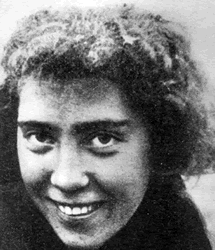
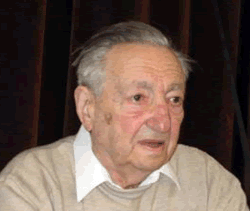
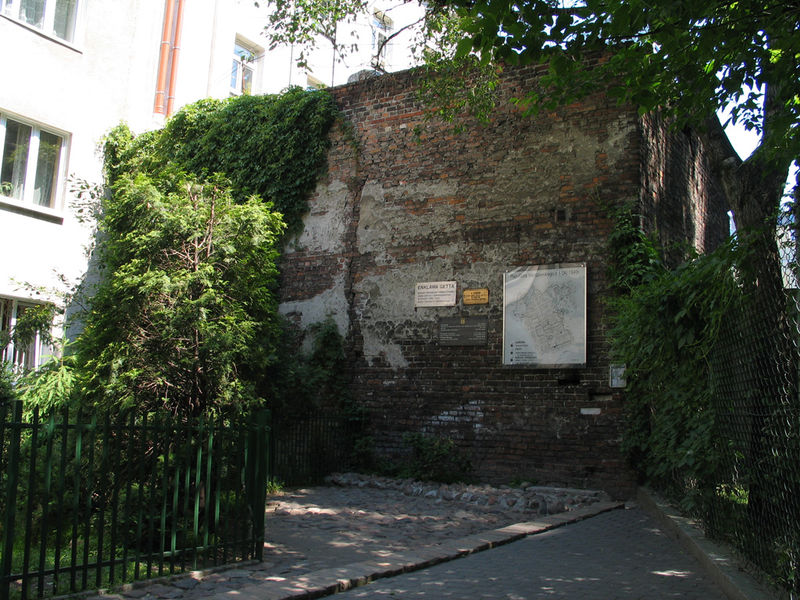


















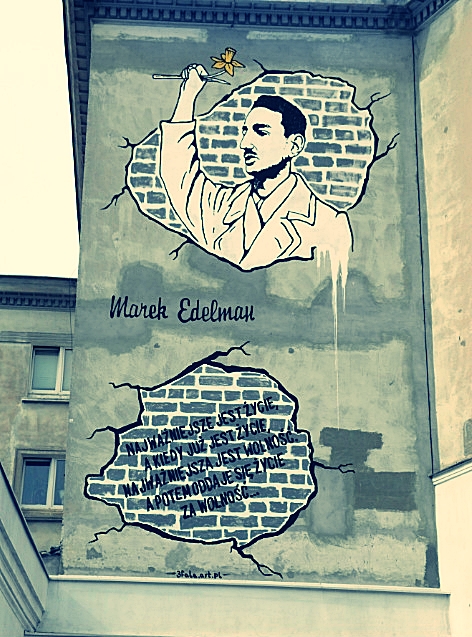




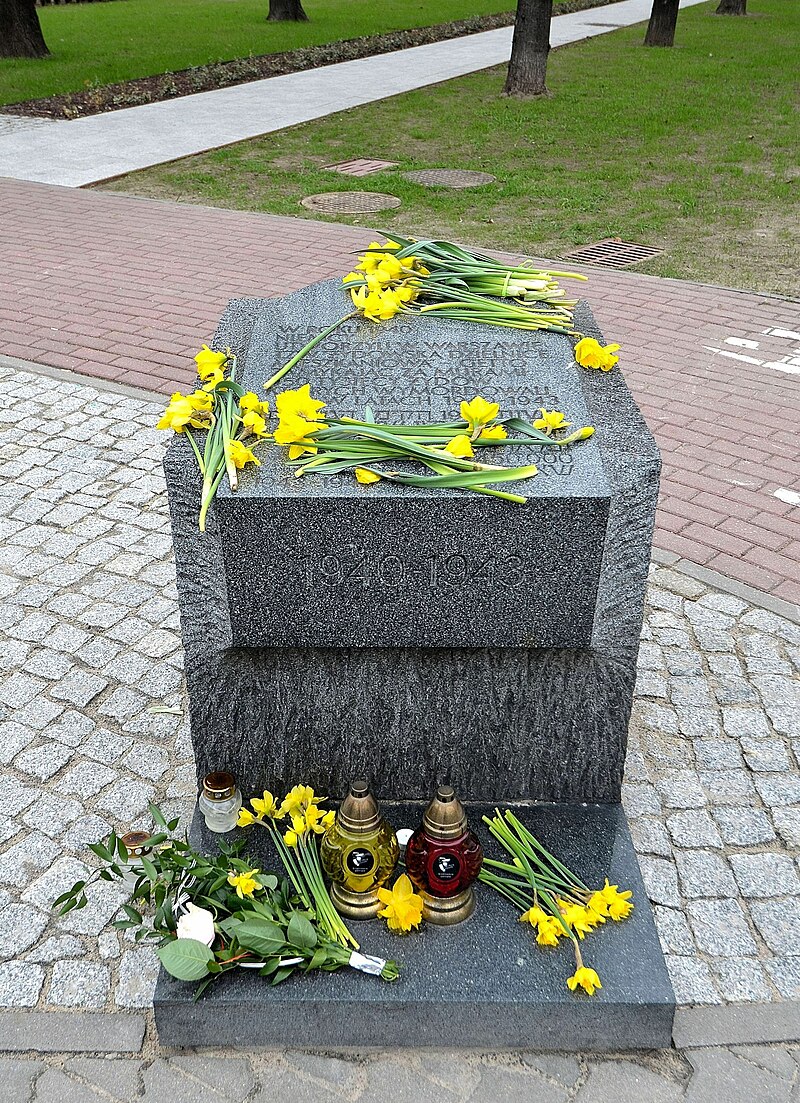



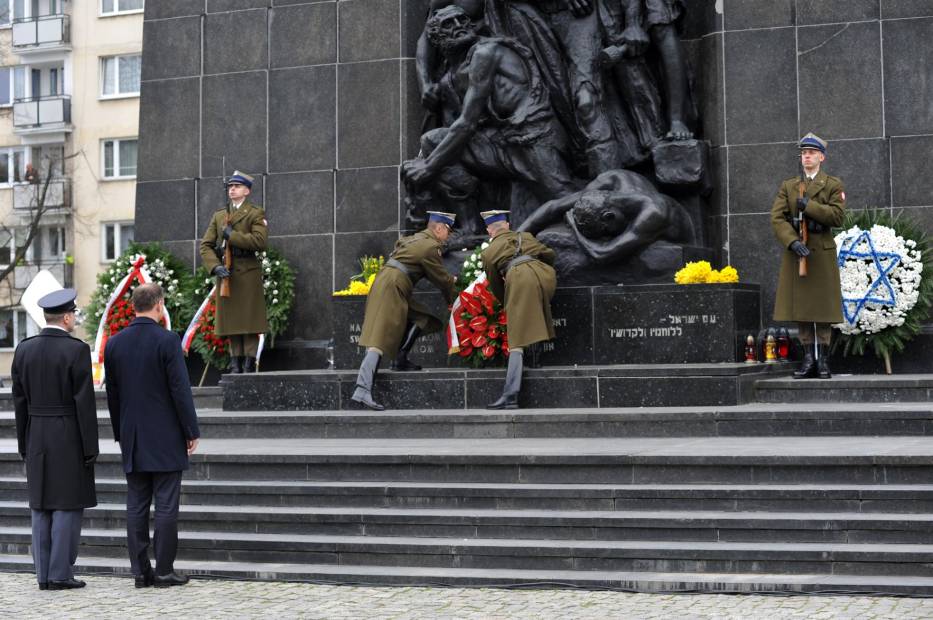

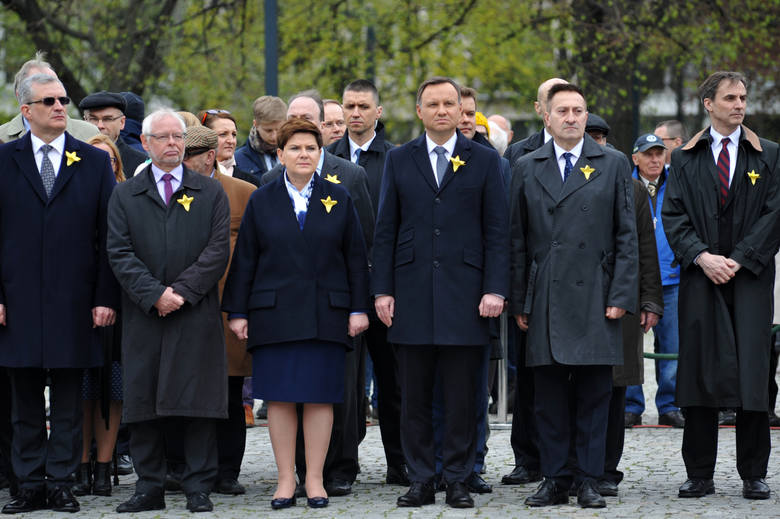
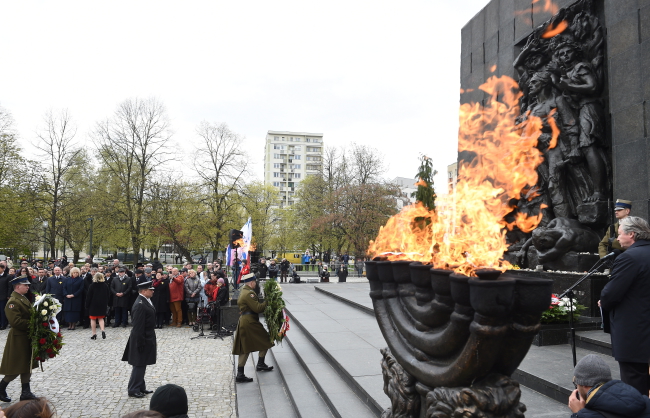

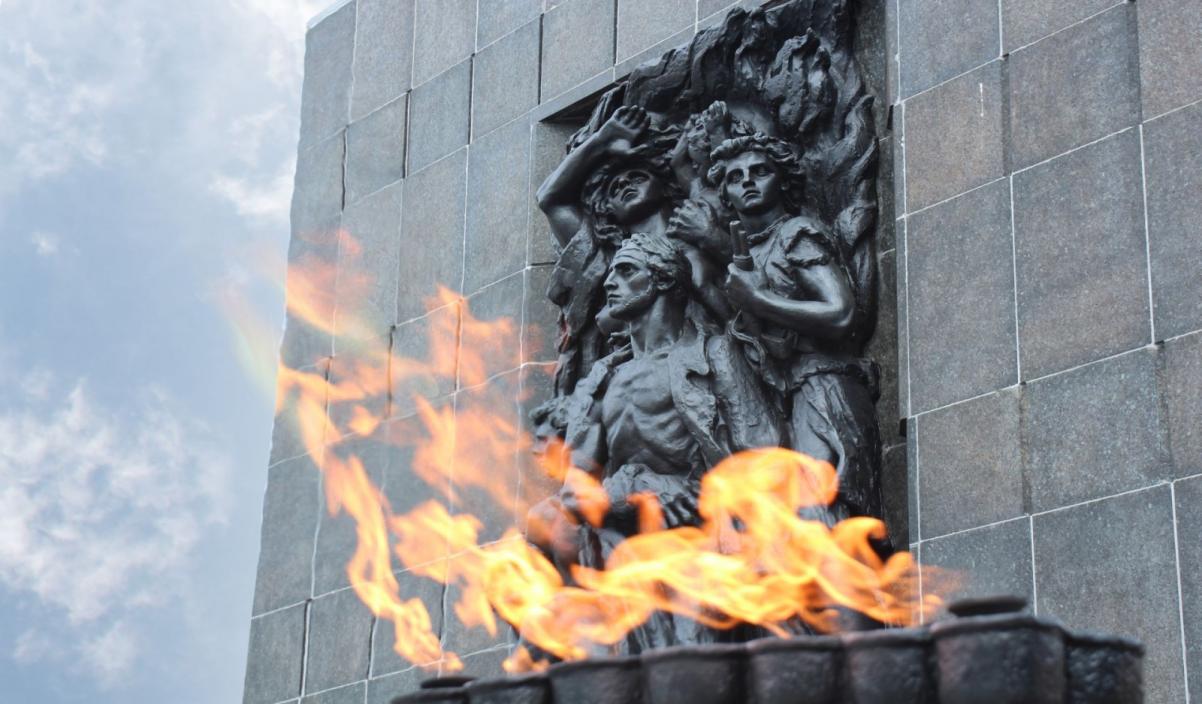
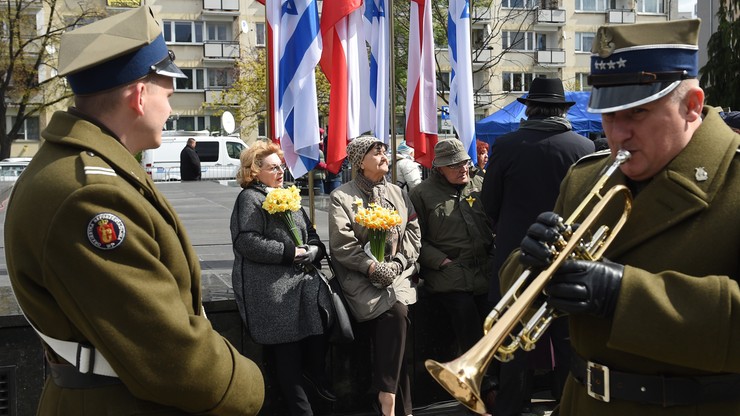

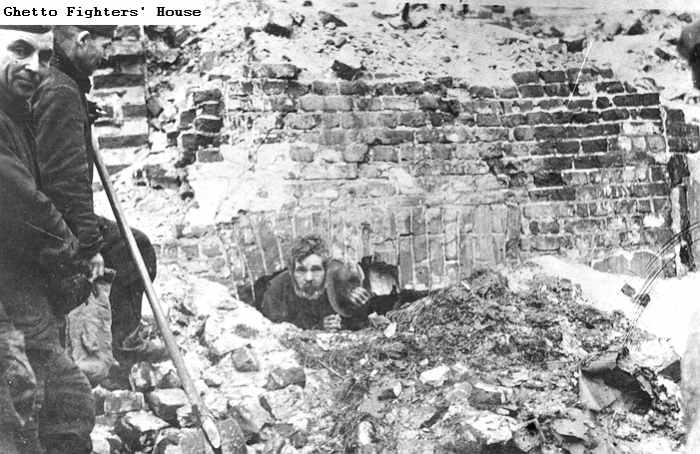
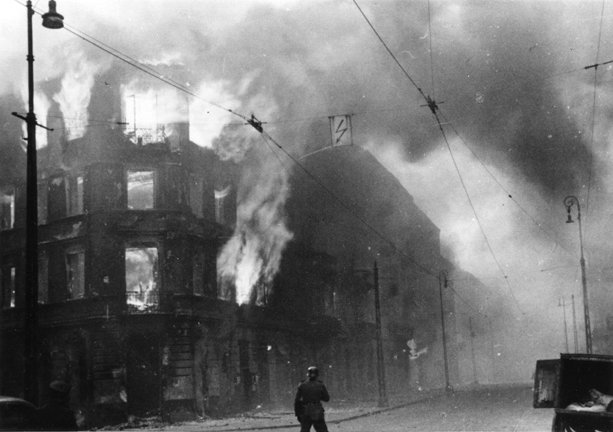
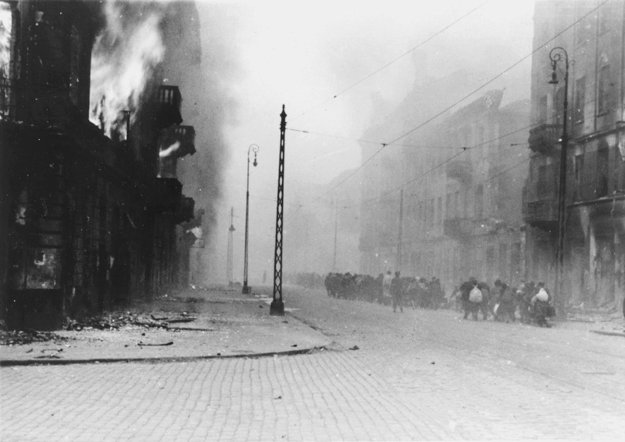
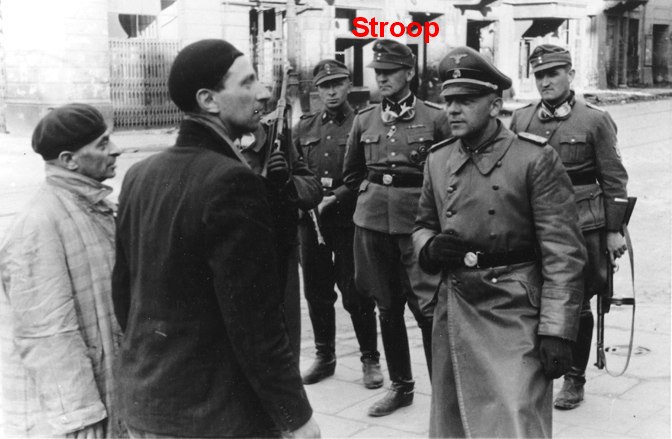
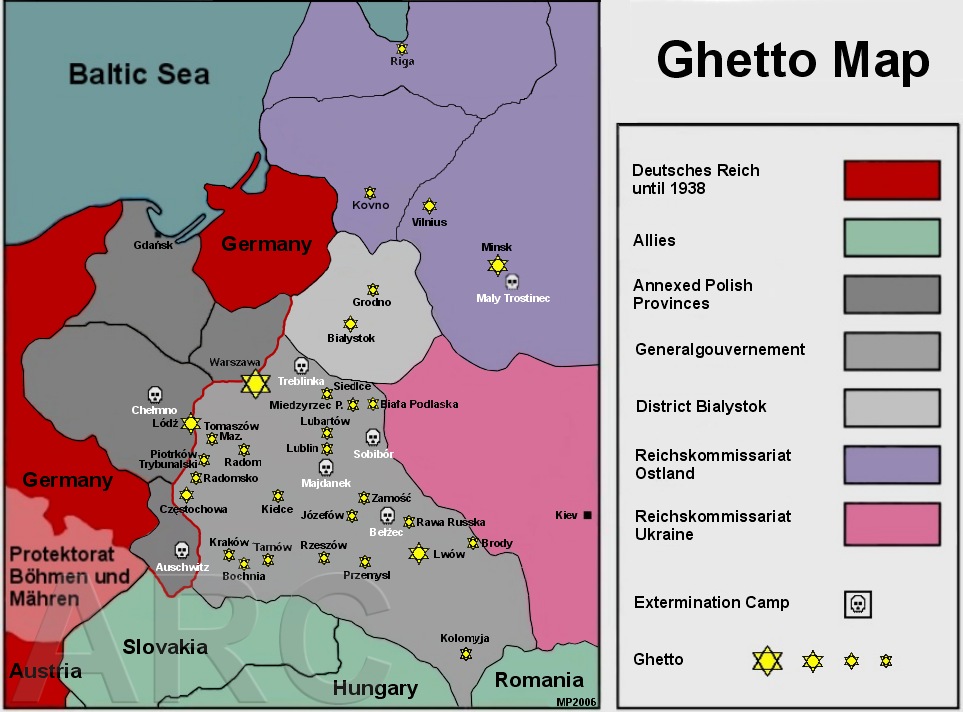
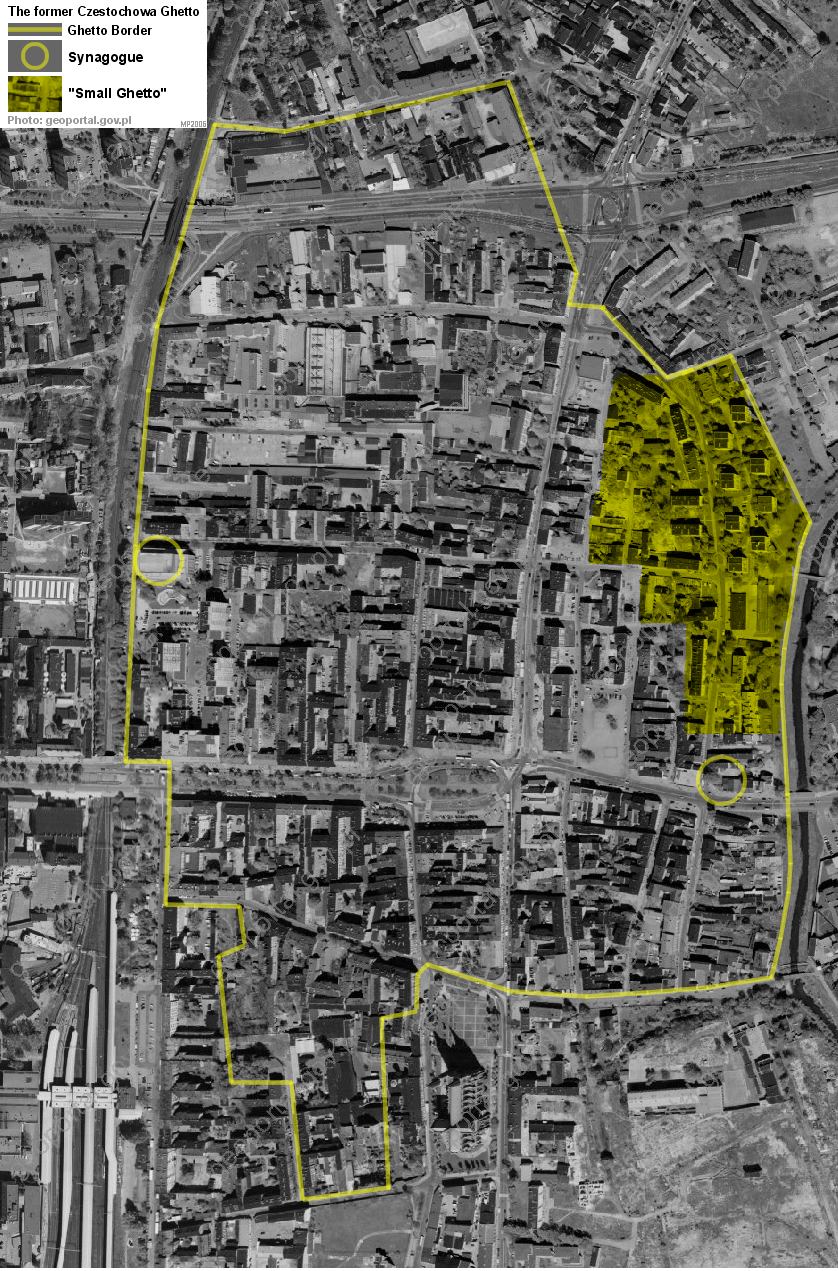
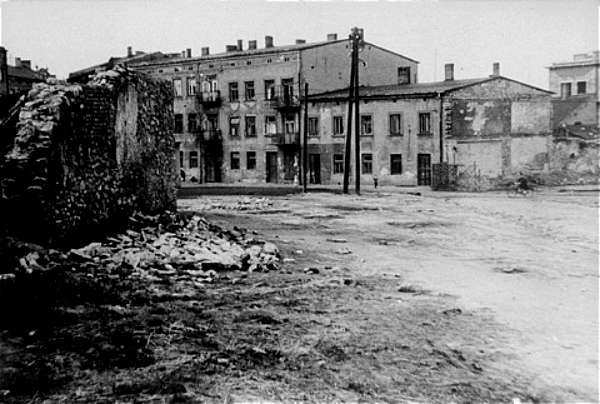
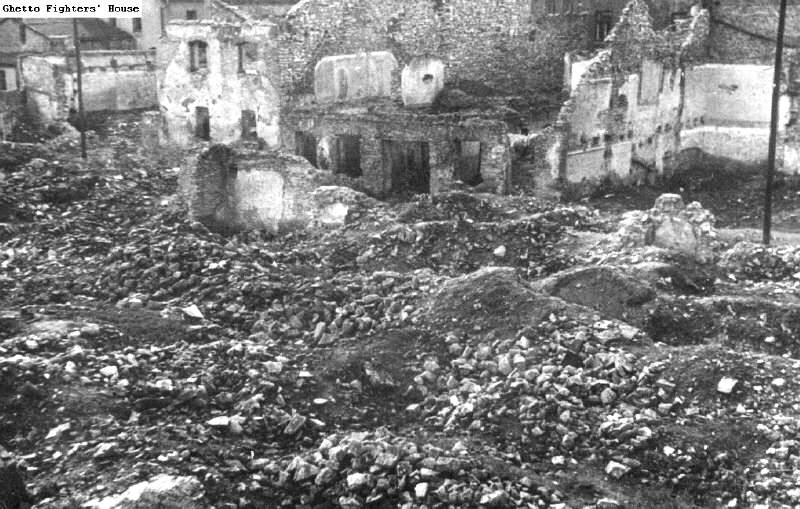
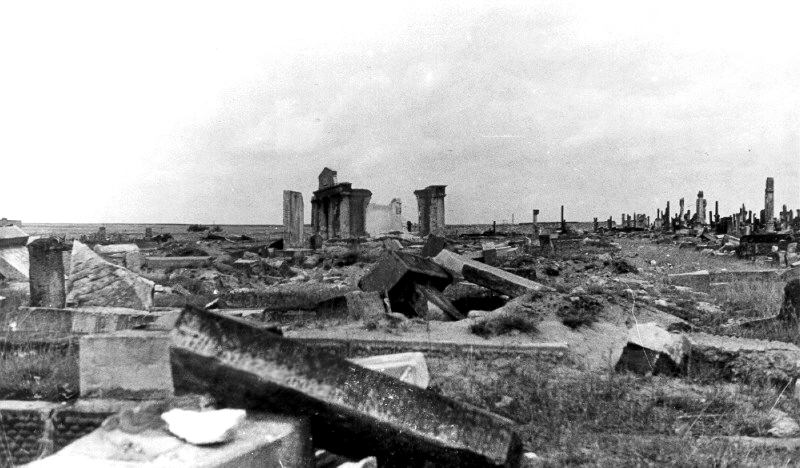
 ).
). 


